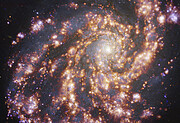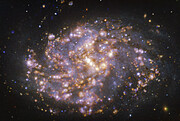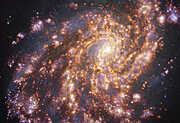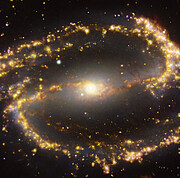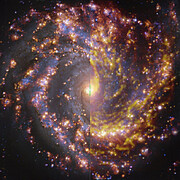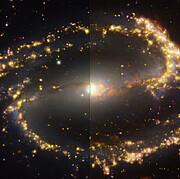Comunicato Stampa
Fuochi d'artificio galattici: nuove immagini dell'ESO rivelano caratteristiche straordinarie in galassie vicine
16 Luglio 2021
Un'equipe di astronomi ha pubblicato nuove osservazioni di galassie vicine che assomigliano a colorati fuochi d'artificio cosmici. Le immagini, ottenute con il Very Large Telescope (VLT) dell'Osservatorio Europeo Australe (ESO), mostrano le diverse componenti delle galassie in colori distinti, consentendo agli astronomi di individuare le posizioni delle stelle giovani e del gas che esse riscaldano. Combinando queste nuove osservazioni con i dati dell'Atacama Large Millimeter/submillimeter Array (ALMA), di cui l'ESO è partner, l'equipe aiuta a gettare nuova luce su ciò che stimola il gas a formare nuove stelle.
Gli astronomi sanno che le stelle nascono all'interno di nubi di gas, ma cosa dia il via alla formazione stellare, e quale ruolo giochino le galassie nel loro insieme, rimane un mistero. Per comprendere questo processo, un'equipe di ricercatori ha osservato varie galassie vicine con potenti telescopi da terra e nello spazio, scansionando le diverse regioni galattiche coinvolte nella nascita delle stelle.
"Per la prima volta riusciamo a risolvere le singole unità di formazione stellare su un ampio intervallo di posizioni e ambienti con un campione di galassie che ne rappresenta bene la varietà", afferma Eric Emsellem, astronomo dell'ESO in Germania e a capo delle osservazione effettuate con il VLT, condotte nell'ambito del progetto Physics at High Angular resolution in Nearby GalaxieS (PHANGS). "Possiamo osservare direttamente il gas che dà vita alle stelle, vediamo le stesse giovani stelle e assistiamo alla loro evoluzione attraverso varie fasi".
Emsellem, che è anche affiliato con l'Università di Lione, in Francia, e il suo gruppo hanno ora pubblicato l'ultima serie di scansioni galattiche, scattate con lo strumento Multi-Unit Spectroscopic Explorer (MUSE) installato sul VLT dell'ESO, nel deserto di Atacama in Cile. Hanno usato MUSE per tracciare le stelle neonate e il gas caldo intorno a loro, illuminato e riscaldato dalle stelle stelle, che funge da cartina al tornasole della formazione stellare in corso.
Le nuove immagini di MUSE vengono ora combinate con le osservazioni delle stesse galassie prese con ALMA e pubblicate all'inizio di quest'anno. ALMA, che pure si trova in Cile, è particolarmente adatto per mappare le nubi di gas freddo, cioè le zone della galassia che forniscono la materia prima da cui si formano le stelle.
Combinando le immagini di MUSE e ALMA gli astronomi possono esaminare le regioni galattiche in cui sta avvenendo la formazione stellare, e confrontarle con quelle in cui si prevede che ciò avvenga, in modo da capire meglio cosa innesca, potenzia o frena la nascita di nuove stelle. Le immagini risultanti sono sbalorditive e offrono una visione vivace e spettacolare delle incubatrici stellari nelle galassie vicine a noi.
"Sono molti i misteri che vorremmo svelare", afferma Kathryn Kreckel dell'Università di Heidelberg in Germania e membro del gruppo PHANGS. “Le stelle nascono più spesso in regioni specifiche delle loro galassie ospiti - e, se sì, perché? E dopo la nascita delle stelle in che modo la loro evoluzione influenza la formazione di nuove generazioni di stelle?"
Gli astronomi saranno ora in grado di rispondere a queste domande grazie alla ricchezza dei dati ottenuti con MUSE e ALMA dall'equipe di PHANGS. MUSE raccoglie gli spettri - i "codici a barre" che gli astronomi scansionano per svelare le proprietà e la natura degli oggetti cosmici - in ogni singola posizione all'interno del suo campo di vista, fornendo così informazioni molto più ricche rispetto agli strumenti tradizionali. Per il progetto PHANGS, MUSE ha osservato 30.000 nebulose di gas caldo e ha raccolto circa 15 milioni di spettri di diverse regioni galattiche. Le osservazioni di ALMA, d'altra parte, hanno permesso agli astronomi di mappare circa 100.000 regioni di gas freddo in 90 galassie vicine, producendo un atlante di incubatrici stellari nell'Universo vicino con una risoluzione senza precedenti.
Oltre ad ALMA e MUSE, il progetto PHANGS include anche osservazioni del telescopio spaziale Hubble della NASA/ESA. I vari osservatori sono stati selezionati per consentire al'equipe di scansionare i nostri vicini galattici a diverse lunghezze d'onda (visibile, vicino infrarosso e radio), di modo che ciascuna banda di lunghezze d'onda riveli parti distinte delle galassie osservate. “La loro combinazione ci consente di sondare le varie fasi della nascita stellare - dalla formazione delle incubatrici stellari all'inizio della formazione stellare stessa e alla distruzione finale dei vivai da parte delle stelle appena nate - in modo più dettagliato di quanto sia possibile con osservazioni individuali", aggiunge Francesco Belfiore, dell'INAF-Arcetri di Firenze, Italia, e membro dell'equipe PHANGS. "PHANGS rappresenta la prima volta in cui siamo stati in grado di mettere insieme una veduta così completa, scattando immagini sufficientemente nitide da vedere le singole nubi di gas, stelle e nebulose che contribuiscono alla formazione stellare".
Il lavoro svolto dal progetto PHANGS sarà ulteriormente affinato dai prossimi telescopi e strumenti, come il James Webb Space Telescope della NASA. I dati ottenuti in questo modo getteranno ulteriori basi per le osservazioni con il futuro Extremely Large Telescope (ELT) dell'ESO, che entrerà in funzione verso la fine di questo decennio e consentirà uno sguardo ancora più dettagliato sulle strutture dei vivai stellari.
"Per quanto sorprendente sia PHANGS, la risoluzione delle mappe che produciamo è appena sufficiente per identificare e separare le singole nubi di formazione stellare, ma non abbastanza per vedere in dettaglio cosa sta succedendo al loro interno", ha sottolineato Eva Schinnerer, a capo di un gruppo di ricerca presso il Max Planck Institute for Astronomy in Germania e investigatore principale del progetto PHANGS, nell'ambito del quale sono state condotte le nuove osservazioni. "Nuovi sforzi osservativi da parte del nostro e di altri gruppi stanno spingendo il confine in questa direzione: abbiamo decenni di scoperte entusiasmanti davanti a noi".
Ulteriori Informazioni
L'equipe internazionale di PHANGS è composta da più di 90 scienzati, su tutta la gamma dagli studenti di master ai pensionati, in 30 diversi istituti in quattro continenti. Il lavoro di riduzione dati di MUSE all'interno di PHANGS è guidato da Eric Emsellem (European Southern Observatory, Garching, Germania e Centre de Recherche Astrophysique de Lyon, Université de Lyon, ENS de Lyon, Saint-Genis Laval, Francia) e comprende Francesco Belfiore (INAF Osservatorio Astrofisico di Arcetri, Firenze, Italia), Guillermo Blanc (Carnegie Observatories, Pasadena, USA), Enrico Congiu (Universidad de Chile, Santiago, Cile e Las Campanas Observatory, Carnegie Institution for Science, Atacama Region, Cile), Brent Grove (The University of Western Australia, Perth, Australia), I-Ting Ho (Max Planck Institute for Astronomy, Heidelberg, Germania [MPIA]), Kathryn Kreckel (Heidelberg University, Heidelberg, Germania), Rebecca McElroy (Sydney Institute for Astronomy, Sydney, Australia), Ismael Pessa (MPIA), Patricia Sanchez-Blazquez (Complutense University of Madrid, Madrid, Spagna), Francesco Santoro (MPIA), Fabian Scheuermann (Heidelberg University, Heidelberg, Germania) e Eva Schinnerer (MPIA).
Potete vedere un esempio delle immagini PHANGS nell'archivio pubblico dell'ESO.
L'ESO (European Southern Observatory, o Osservatorio Australe Europeo) è la principale organizzazione intergovernativa di Astronomia in Europa e di gran lunga l'osservatorio astronomico più produttivo al mondo. È sostenuto da 16 paesi: Austria, Belgio, Danimarca, Finlandia, Francia, Germania, Irlanda, Italia, Paesi Bassi, Polonia, Portogallo, Regno Unito, Repubblica Ceca, Spagna, Svezia, e Svizzera, oltre al paese che ospita l'ESO, il Cile e l'Australia come partner strategico. L'ESO svolge un ambizioso programma che si concentra sulla progettazione, costruzione e gestione di potenti strumenti astronomici da terra che consentano agli astronomi di realizzare importanti scoperte scientifiche. L'ESO ha anche un ruolo di punta nel promuovere e organizzare la cooperazione nella ricerca astronomica. L'ESO gestisce tre siti osservativi unici al mondo in Cile: La Silla, Paranal e Chajnantor. Sul Paranal, l'ESO gestisce il Very Large Telescope, osservatorio astronomico d'avanguardia nella banda visibile e due telescopi per survey. VISTA, il più grande telescopio per survey al mondo, lavora nella banda infrarossa mentre il VST (VLT Survey Telescope) è il più grande telescopio progettato appositamente per produrre survey del cielo in luce visibile. L'ESO è il partner principale di APEX e di ALMA, il più grande progetto astronomico esistente, sulla piana di Chajnantor. E sul Cerro Armazones, vicino al Paranal, l'ESO sta costruendo l'Extremely Large Telescope o ELT (significa Telescopio Estremamente Grande), un telescopio da 39 metri che diventerà "il più grande occhio del mondo rivolto al cielo".
La traduzione dall'inglese dei comunicati stampa dell'ESO è un servizio dalla Rete di Divulgazione Scientifica dell'ESO (ESON: ESO Science Outreach Network) composta da ricercatori e divulgatori scientifici da
Links
- Sito online di PHANGS
- Lo strumento MUSE
- Immagini del VLT
- Fotografie di ALMA
- Per i giornalisti: iscrivetevi per ricevere i nostri comunicati sotto embargo nella vostra lingua
- Per i ricercatori: avete una storia da raccontare? Inviateci il vostro articolo scientifico
Contatti
Eric Emsellem
European Southern Observatory
Garching bei München, Germany
Tel.: +49 89 3200 6914
E-mail: eric.emsellem@eso.org
Eva Schinnerer
Max Planck Institute for Astronomy
Heidelberg, Germany
Tel.: +49 6221 528 294
E-mail: schinner@mpia.de
Kathryn Kreckel
Astronomisches Recheninstitut, Zentrum für Astronomie, Universität Heidelberg
Heidelberg, Germany
E-mail: kathryn.kreckel@uni-heidelberg.de
Francesco Belfiore
INAF Osservatorio Astrofisico di Arcetri
Florence, Italy
E-mail: francesco.belfiore@inaf.it
Bárbara Ferreira
ESO Media Manager
Garching bei München, Germany
Tel.: +49 89 3200 6670
Cell.: +49 151 241 664 00
E-mail: press@eso.org
Joerg Gasser (press contact Svizzera)
Rete di divulgazione scientifica dell'ESO
E-mail: eson-switzerland@eso.org
Sul Comunicato Stampa
| Comunicato Stampa N": | eso2110it-ch |
| Nome: | NGC 1087, NGC 1300, NGC 3627, NGC 4254, NGC 4303 |
| Tipo: | Local Universe : Galaxy : Type : Spiral Local Universe : Galaxy : Type : Barred |
| Facility: | Atacama Large Millimeter/submillimeter Array, Very Large Telescope |
| Instruments: | MUSE |
Our use of Cookies
We use cookies that are essential for accessing our websites and using our services. We also use cookies to analyse, measure and improve our websites’ performance, to enable content sharing via social media and to display media content hosted on third-party platforms.
ESO Cookies Policy
The European Organisation for Astronomical Research in the Southern Hemisphere (ESO) is the pre-eminent intergovernmental science and technology organisation in astronomy. It carries out an ambitious programme focused on the design, construction and operation of powerful ground-based observing facilities for astronomy.
This Cookies Policy is intended to provide clarity by outlining the cookies used on the ESO public websites, their functions, the options you have for controlling them, and the ways you can contact us for additional details.
What are cookies?
Cookies are small pieces of data stored on your device by websites you visit. They serve various purposes, such as remembering login credentials and preferences and enhance your browsing experience.
Categories of cookies we use
Essential cookies (always active): These cookies are strictly necessary for the proper functioning of our website. Without these cookies, the website cannot operate correctly, and certain services, such as logging in or accessing secure areas, may not be available; because they are essential for the website’s operation, they cannot be disabled.
Functional Cookies: These cookies enhance your browsing experience by enabling additional features and personalization, such as remembering your preferences and settings. While not strictly necessary for the website to function, they improve usability and convenience; these cookies are only placed if you provide your consent.
Analytics cookies: These cookies collect information about how visitors interact with our website, such as which pages are visited most often and how users navigate the site. This data helps us improve website performance, optimize content, and enhance the user experience; these cookies are only placed if you provide your consent. We use the following analytics cookies.
Matomo Cookies:
This website uses Matomo (formerly Piwik), an open source software which enables the statistical analysis of website visits. Matomo uses cookies (text files) which are saved on your computer and which allow us to analyze how you use our website. The website user information generated by the cookies will only be saved on the servers of our IT Department. We use this information to analyze www.eso.org visits and to prepare reports on website activities. These data will not be disclosed to third parties.
On behalf of ESO, Matomo will use this information for the purpose of evaluating your use of the website, compiling reports on website activity and providing other services relating to website activity and internet usage.
Matomo cookies settings:
Additional Third-party cookies on ESO websites: some of our pages display content from external providers, e.g. YouTube.
Such third-party services are outside of ESO control and may, at any time, change their terms of service, use of cookies, etc.
YouTube: Some videos on the ESO website are embedded from ESO’s official YouTube channel. We have enabled YouTube’s privacy-enhanced mode, meaning that no cookies are set unless the user actively clicks on the video to play it. Additionally, in this mode, YouTube does not store any personally identifiable cookie data for embedded video playbacks. For more details, please refer to YouTube’s embedding videos information page.
Cookies can also be classified based on the following elements.
Regarding the domain, there are:
- First-party cookies, set by the website you are currently visiting. They are stored by the same domain that you are browsing and are used to enhance your experience on that site;
- Third-party cookies, set by a domain other than the one you are currently visiting.
As for their duration, cookies can be:
- Browser-session cookies, which are deleted when the user closes the browser;
- Stored cookies, which stay on the user's device for a predetermined period of time.
How to manage cookies
Cookie settings: You can modify your cookie choices for the ESO webpages at any time by clicking on the link Cookie settings at the bottom of any page.
In your browser: If you wish to delete cookies or instruct your browser to delete or block cookies by default, please visit the help pages of your browser:
Please be aware that if you delete or decline cookies, certain functionalities of our website may be not be available and your browsing experience may be affected.
You can set most browsers to prevent any cookies being placed on your device, but you may then have to manually adjust some preferences every time you visit a site/page. And some services and functionalities may not work properly at all (e.g. profile logging-in, shop check out).
Updates to the ESO Cookies Policy
The ESO Cookies Policy may be subject to future updates, which will be made available on this page.
Additional information
For any queries related to cookies, please contact: pdprATesoDOTorg.
As ESO public webpages are managed by our Department of Communication, your questions will be dealt with the support of the said Department.



